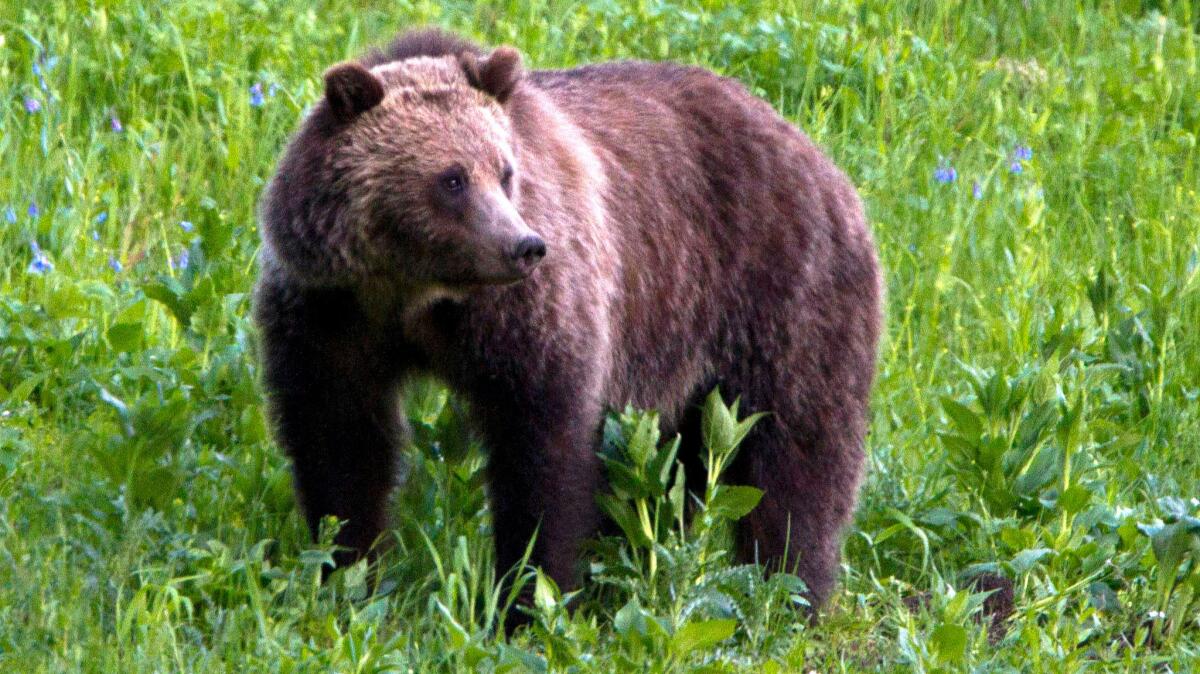Op-Ed: Don’t delist Yellowstone’s grizzlies

- Share via
Consider the grizzly bear, while you can. Gone from California since 1924, despite gracing the state flag. Gone from Utah the year before that, when Mormon Boy Scouts stoned to death a bear called Old Ephraim. In Colorado, the last grizzly was thought to have been killed in 1952, though one more was found and killed by a bow hunter in 1979.
Now in Montana, Wyoming and Idaho there is a move to remove — “delist” — endangered-species protection for the grizzly bears in the Greater Yellowstone Ecosystem. These “recovered” bears would be subject to a trophy-hunting season should they venture — as they do — outside Grand Teton and Yellowstone national parks.
Delisting is a terrible idea, motivated more by politics than science. The U.S. Fish and Wildlife Service is seeking a splashy “mission accomplished” victory by “saving” an important endangered species. Western conservatives would like to see grizzlies, and everything else on public lands, controlled by individual states: a bewildering Balkanization of nature.
However encouraging Yellowstone’s slow rebound, these bears remain in jeopardy.
As to the condition of the bears, after 40 years of federal protection and intense conservation efforts, Yellowstone’s grizzlies may have only a little more than doubled, to 700 or so, up from population estimates that ranged from 136 to 312 when the grizzly was declared endangered in the 1970s. (About 1,800 grizzlies now survive in the U.S. outside Alaska, scattered in less than 1% of their historic range.) However encouraging Yellowstone’s slow rebound, these bears remain in jeopardy.
What science there is behind the delisting effort purposely avoids a full examination of the risks grizzlies still face. In even the wildest parts of Montana, Idaho and Wyoming, the bear’s richest food sources are vanishing. Pine nuts, the single most important food for female grizzlies with cubs, are disappearing along with the whitebark pine, a victim of the bark beetle and the warming climate. Mother bears with cubs are unable to feed on winter-killed bison, which are claimed by larger males.
Another diminishing resource grizzlies require: wide swaths of secure, wild country without roads. Better yet, wide swaths of wild country that are connected, so the small remnant grizzly populations in the contiguous U.S. and Canada can intermingle.
The Fish and Wildlife Service doesn’t deny such needs so much as ignore them. It justifies delisting the Yellowstone bears based primarily on the size of the population, even though its estimates are just that — a matter of sample counts and extrapolation (bears don’t sit still for a census). Nor is the agency asking how many of the bears are females, or how old they are. It’s no real science at all.
Delisting proponents go so far as to suggest that grizzlies in the greater Yellowstone area have outgrown the ecosystem. The proof, they say, is that bears are showing up where they haven’t been seen in years. But the real reason for the grizzlies’ spread may be simpler. With their food and habitat ever diminishing, they are venturing into unfamiliar places, often closer to humans, where “negative interactions” get bears killed despite their endangered-species status.
Under these circumstances, trophy hunting should be out of the question; it is the worst of what delisting would bring. Besides the obvious threat it represents, no one seems to have thought about what to do with the wounded bears that will escape — pioneer journals remind us it takes a lot of flying lead to bring down such a large animal. Bigger bears will be most — not all — hunters’ prizes. What of the cubs and sub-adults that will be left behind? Younger populations are more fragile; young bears disperse widely, leading to more negative human-bear interactions.
Big-game hunters and others argue that if Yellowstone’s bear population falls precipitously after delisting, the federal government can come back in and declare the bears endangered again. But “relisting” is a lengthy process, sometimes requiring decades, and it is highly politicized. The Fish and Wildlife Service generally doesn’t list a species as endangered unless ordered to do so by a court. In the meantime, grizzly bears would keep dying, and the culture of the surviving bears would be altered further.
Yellowstone’s bears aren’t the only grizzly population the federal government is willing to put at risk. In the isolated million-acre Yaak Valley of northwestern Montana, maybe 20 or so grizzlies are left — perhaps only five breeding-age females — and yet local U.S. Forest Service leadership supports creating and promoting a recreational trail in that territory. This new human highway, along the Canadian-U.S. border (and a known drug-trafficking interface), would bring thousands of legal users and countless unpermitted wayfarers into the heart of habitat that is supposedly committed to grizzly bear recovery.
The grizzly is the West’s, and the nation’s, most intriguing, complicated and sentient land mammal. It represents the gold standard of wildness, the “intangible and spiritual resource” that is the fabric of the American character, as Wallace Stegner famously wrote.
It will be a historic mistake if the federal government delists the grizzly, over the outcry of independent scientists and, indeed, even over the doubts of the superintendent of Yellowstone National Park, Dan Wenk. The great bear deserves better. So does the great American wilderness, which like everything else is in swirling, fragmenting readjustment due to the onrush of global warming. Amid such turbulence, the best science should matter more, not less, than ever.
Rick Bass is a long-time Montanan, a board member of the Yaak Valley Forest Council and writer-in-residence at Montana State University. His latest book is the short story collection “For a Little While.” The public comment period on grizzly delisting closes on Friday.
Follow the Opinion section on Twitter @latimesopinion and Facebook
A cure for the common opinion
Get thought-provoking perspectives with our weekly newsletter.
You may occasionally receive promotional content from the Los Angeles Times.



